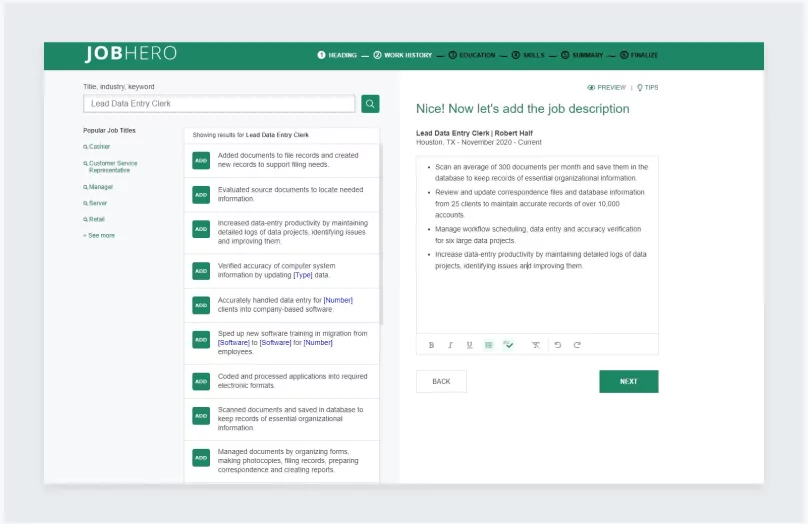Read on if you’d like to know the education requirements necessary to become a physical therapist. This how to become a physiotherapist guide covers academic requirements, regional and national salary estimates and mentorship feedback.
Our team of certified resume writers have created a library of resume examples to show you how to craft a strong resume. Study them to learn to write your own.
Impress your future boss! According to a 2020 survey, most hiring managers read cover letters for candidates they’re considering interviewing before making their final decision. Make a cover letter that seals the deal with our professionally designed cover letter templates.

Create your professional resume in just minutes.
- Choose from 20+ recommended templates
- Add pre-written experiences, skills and summary
- Download and send
What Does a Physiotherapist Do?
A physiotherapist, also known as a physical therapist or a PT, works with injured or ill people to help them improve their range of movement and manage their pain. Physiotherapists work primarily with patients suffering from chronic conditions, illnesses, injuries, or recently recovering from surgery. They work in various settings, including hospitals, clinics, gyms or private homes.
A physiotherapist will employ various techniques to care for the patient and help them reach their physical goals, depending on their needs. Some common physiotherapy duties and responsibilities include:
Diagnose patients. Physiotherapists observe patients’ movements and listen to their health concerns, and then use that information to diagnose their physical ailments.
Develop patient care plans. Based on their diagnosis, physiotherapists will outline a detailed care plan for each patient, individualized to their needs and goals.
Use exercises, stretches, hands-on therapy, and equipment to help patients increase mobility and fitness or ease pain.
Evaluate the patient’s progress, monitor the patient’s progress and modify the plan as needed to reach the desired results.
Adapt various teachings to help patients meet their physical goals. These techniques include exercises like swimming or stretching but can consist of training in functional skills such as using walkers, wheelchairs or prosthetic limbs.
How Do You Become a Physiotherapist?
The Bureau of Labor Statistics anticipates employment of physiotherapists to grow by 34% over the next 10 years, much faster than the average for all occupations. An aging population, combined with a growing number of chronic diseases such as diabetes and obesity, means there will be no shortage of demand for Physiotherapists in the coming years.
You can follow these steps to become a physiotherapist to reach your career goals:
Apply for an undergraduate bachelor’s degree in a relevant field.
There’s no specific undergraduate degree related to physical therapy. However, pursuing a degree in nursing, physiology, chemistry, biology, physics, anatomy or sports medicine can help you develop relevant medical knowledge for your future education.
Complete your doctor of physical therapy (DPT) degree or postgraduate physical therapy program.
Most states have different requirements to qualify for a physiotherapist license. Some require you to complete a short physical therapy training program — others may require a doctorate in physical therapy. Find out what training your state needs before you pursue additional educational programs.
A DPT program usually lasts three years and typically includes biomechanics, anatomy, physiology and pharmacology courses. Students complete at least 30 weeks of clinical work during the DPT program. During this clinical work, students gain experience in specific areas of physiotherapy under supervision.
Pass the National Physical Therapy Examination.
The NPTE is designed to assess your entry-level PT knowledge. You’ll need to pass this exam after graduation from training or graduate programs before you can apply for a state license to practice as a certified physiotherapist.
Apply for a state license to operate as a certified physiotherapist.
Physiotherapists must also be licensed by the state in which they practice. You can learn more about the various state and regional licensing requirements through the Federation of State Boards of Physical Therapy.
Apply for a one-year clinical residency.
Once you complete your medical degree, you’ll need to apply for a medical residency to continue your training with real-world training. The American Board of Physical Therapy Residency and Fellowship Education keeps an up-to-date directory of open, accredited residencies where you can continue your education.
Register for an advanced clinical fellowship.
After your residency, you can develop specialized PT knowledge under a fellowship program. These eight specialty fields include orthopedics, sports medicine, clinical electrophysiology, geriatrics, neurology, and cardiovascular and pulmonary physical therapy. You can find a detailed list of accredited physical therapy fellowship programs with the American Board of Physical Therapy.
Your last step is to search online for physiotherapist job opportunities. As you look for openings, leverage your professional network, including people you met through school, internships and residency programs. For help getting your resume just right, review our physiotherapist resume samples to see how your former classmates describe their education and training.
If you’re still unsure about how to start your resume, try using our Resume Builder. This powerful tool scans multiple job openings and previous applicants to suggest hiring-friendly text templates based on your experience and industry.
Physiotherapist Skills
A professional physiotherapist must present strong medical knowledge and compassion. The following combination of hard skills and soft social skills can help you craft a warm but professional relationship with your patients.
Hard skills:
Soft skills:
Insights from a Physiotherapist
To get an expert’s take on how to become a Physical Therapists, we talked to Kadeem Howell, a Doctor of Physical Therapy in New York City. Here’s what he had to say.
What is the common career path for Physiotherapists?
To become a Physical Therapist in the United States you must first complete a 4-year bachelor’s degree in any major/field of your choice. Within completing an undergraduate degree it is important to fulfill the prerequisite course work and observation hours required for a given school. After that degree you must complete 3 years of graduate school to obtain your doctorate in Physical Therapy. A doctorate is the new baseline degree to become a Physical Therapist, in the past a Bachelors or a Master's was the minimum degree.
What should someone consider before becoming a Physiotherapist?
Someone should consider "why physical therapy is important to you?" The common answer to this question is usually "because I want to help people." Not a bad answer, however there are multiple ways to help people, especially within healthcare. Physical therapy should mean something to you on a personal level. For example maybe a family member, a loved one, or even yourself required physical therapy, which lead you to see the benefits of the profession. Physical Therapists are usually very passionate about the field and don't treat going to work as simply a job to pay the bills.
What type of person excels in this job?
To excel in physical therapy I believe it is important that someone is able to leave their outside life stresses at the door. What I mean by this is that if you’re having a bad day you cannot give off negative body language while working. This negative vibe will translate to the patient and effect that treatment session and the rest of the session throughout the day. Someone who is able to be fully invested into the patient standing right in front of them will be able to excel in the field.
What are some of the most important skills for Physiotherapists to have?
The most important skill a Physical Therapist can have is effective communication. Effective communication ensures that the patient is being heard and that their needs are being met. Inability to establish effective communication can negatively affect outcomes and lead to poor patient rapport.
Another important skill is to be able to show empathy and not sympathy. Chances are most people have displayed sympathy to a patient feeling sorry for them. This is usually true for a patient who is post surgical, in chronic pain, or after a traumatic accident. As Physical Therapist it is important to not fall into this trap and not feel sorry for a patient. Instead show that you understand what they are going through and explain how they are going to overcome their current obstacles. In Physical Therapist school our professors told us "patients won't care how much you know, until they know how much you care."
What do you find to be the most rewarding aspect of being a Physiotherapist?
Our main goal as Physical Therapist is to have someone achieve their goal, whatever it may be. Oftentimes the goal is to get back to work, back to playing sports, and just being able to walk again. The true rewarding aspect of this profession is when you receive a follow up visit or a thank you card from a patient. This small gesture goes a long way, and makes the career come full circle.
How Much Do Physiotherapists Get Paid?
Physiotherapists are paid either an hourly or a salaried rate, depending where they work. The median annual wage in the United States for Physiotherapists is $84,020. The lowest-paid physiotherapists earned less than $57,060 a year, and the highest-paid earn more than $119,790.
Top 10 States for Physiotherapist Salary
Physiotherapists in the following states make the highest median hourly wage in the U.S.
Physiotherapist Resources
If you’d like to learn more about becoming a Physiotherapist, here is a list of additional resources that can help you as you continue to explore this career option.
On the Web
Modern Manual Therapy
Follow this blog to get all kinds of up-to-date information on the world of physical therapy, including seminars and podcasts.
Dr. Jarod Carter
This is an incredibly helpful bog for private practice Physiotherapists, that will walk you through the steps of setting up and running your own practice.
The Awesome Physical Therapist
This is a light-hearted blog that spills on the joys and pains of being a Physiotherapist, and includes interviews with professionals, too.
Industry Groups
American Physical Therapy Association
The number one source for career information and industry news.
American Board of Physical Therapy Specialties
Find out more about Physiotherapist certification.
Physiotherapist Books
Therapeutic Exercise: Foundations and Techniques, 6th Edition
Learn the essentials of physiotherapy from this text written by an expert PT.
The Physiotherapist's Pocketbook: Essential Facts at Your Fingertips, 2e
A comprehensive reference to help you in your studies or daily practice as a Physiotherapist.




